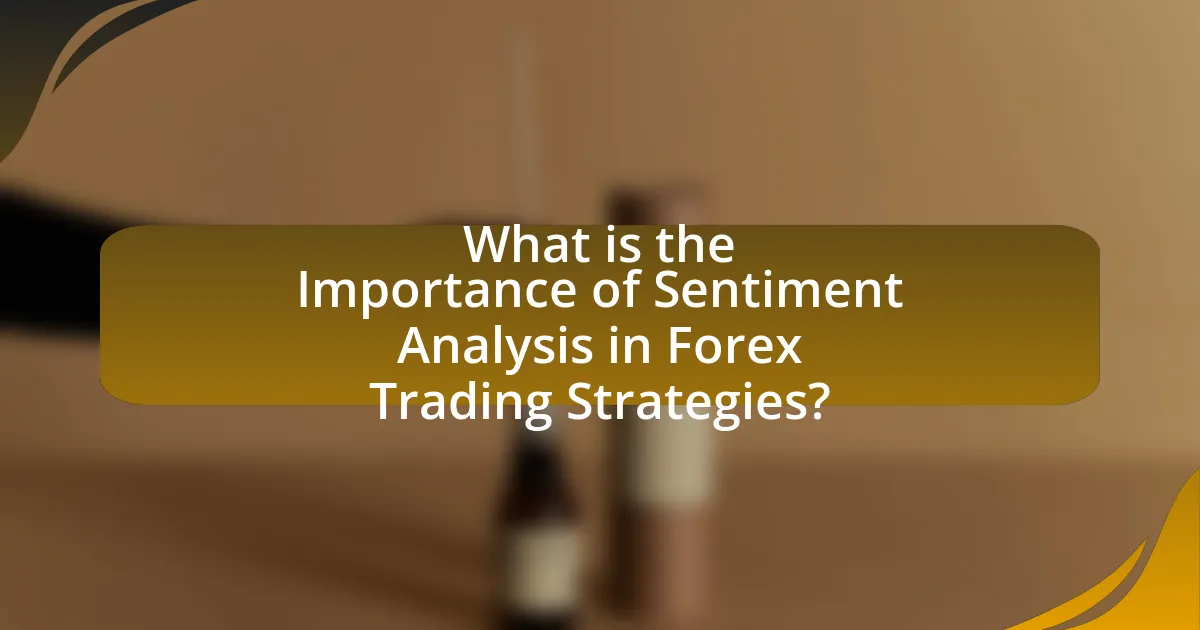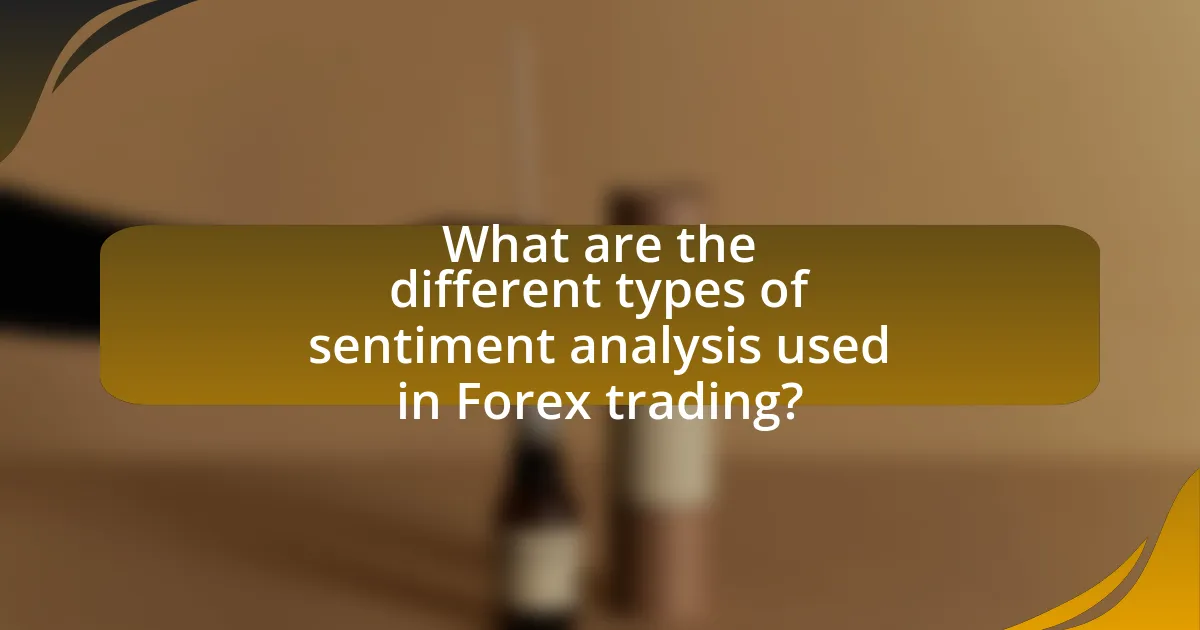Sentiment analysis plays a vital role in Forex trading strategies by enabling traders to assess market sentiment and forecast price movements. The article explores how sentiment analysis influences trading decisions through various indicators, including the Commitment of Traders report and social media sentiment. It highlights the advantages of sentiment analysis over traditional methods, the different types of sentiment analysis applicable in Forex, and practical tips for effectively integrating sentiment data into trading strategies. Additionally, it discusses the impact of news and social media on market movements, emphasizing the importance of real-time sentiment data for informed trading decisions.

What is the Importance of Sentiment Analysis in Forex Trading Strategies?
Sentiment analysis is crucial in Forex trading strategies as it helps traders gauge market sentiment and predict price movements. By analyzing social media, news articles, and trader sentiment indicators, traders can identify bullish or bearish trends. For instance, a study by the University of California found that sentiment analysis of Twitter data can predict stock price movements with an accuracy of up to 87%. This demonstrates that understanding market sentiment can significantly enhance trading decisions and improve profitability in Forex markets.
How does sentiment analysis influence Forex trading decisions?
Sentiment analysis significantly influences Forex trading decisions by providing insights into market psychology and trader behavior. Traders utilize sentiment analysis to gauge the overall mood of the market, which can indicate potential price movements. For instance, when sentiment is overwhelmingly positive, it may suggest that traders expect currency appreciation, prompting buying activity. Conversely, negative sentiment can signal anticipated depreciation, leading to selling. Research shows that sentiment indicators, such as the Commitment of Traders report, can predict price trends with a degree of accuracy, reinforcing the importance of sentiment analysis in making informed trading decisions.
What are the key indicators of sentiment in Forex markets?
Key indicators of sentiment in Forex markets include the Commitment of Traders (COT) report, market news sentiment, and social media sentiment analysis. The COT report, published weekly by the Commodity Futures Trading Commission, provides insights into the positions of various market participants, indicating whether traders are predominantly bullish or bearish. Market news sentiment is gauged through the analysis of headlines and reports, which can influence trader perceptions and decisions. Additionally, social media sentiment analysis utilizes algorithms to assess the mood of traders based on discussions and posts, reflecting real-time sentiment shifts. These indicators collectively help traders understand market psychology and make informed trading decisions.
How can traders interpret sentiment data effectively?
Traders can interpret sentiment data effectively by analyzing market indicators, news sentiment, and social media trends to gauge the overall mood of market participants. By utilizing tools such as the Commitment of Traders (COT) report, which provides insights into the positions of various market participants, traders can identify whether the market sentiment is bullish or bearish. Additionally, sentiment analysis platforms aggregate data from news articles and social media, allowing traders to quantify public sentiment towards specific currencies. Research indicates that sentiment data can predict price movements; for instance, a study by Baker and Wurgler (2006) found that investor sentiment significantly affects stock returns, suggesting similar implications in forex markets. Thus, by combining these analytical methods, traders can make informed decisions based on the prevailing sentiment in the market.
Why is sentiment analysis crucial for successful Forex trading?
Sentiment analysis is crucial for successful Forex trading because it helps traders gauge market sentiment and predict price movements based on collective trader emotions and opinions. By analyzing social media, news articles, and market reports, traders can identify bullish or bearish trends that influence currency values. For instance, a study by the University of California found that sentiment analysis of Twitter data can predict stock price movements with an accuracy of up to 87%. This demonstrates that understanding market sentiment can provide traders with a competitive edge, allowing them to make informed decisions and enhance their trading strategies.
What advantages does sentiment analysis provide over traditional analysis methods?
Sentiment analysis offers several advantages over traditional analysis methods, primarily through its ability to process large volumes of unstructured data quickly and accurately. Unlike traditional methods that often rely on quantitative metrics, sentiment analysis leverages natural language processing to gauge public opinion and emotional tone from sources such as social media, news articles, and forums. This capability allows traders to capture market sentiment in real-time, providing insights that can lead to more informed trading decisions. For instance, a study by Bollen et al. (2011) demonstrated that Twitter sentiment could predict stock market movements, highlighting the predictive power of sentiment analysis compared to conventional financial indicators.
How does sentiment analysis help in predicting market trends?
Sentiment analysis aids in predicting market trends by quantifying the emotional tone of market participants’ communications, such as news articles, social media posts, and financial reports. This analysis allows traders to gauge public sentiment towards specific currencies or economic conditions, which can influence buying or selling decisions. For instance, a study by Zhang et al. (2018) demonstrated that positive sentiment correlated with rising currency values, while negative sentiment often preceded declines. By leveraging sentiment analysis, traders can make informed predictions about future market movements based on prevailing attitudes and emotions within the market.

What are the different types of sentiment analysis used in Forex trading?
The different types of sentiment analysis used in Forex trading include market sentiment analysis, news sentiment analysis, and social media sentiment analysis. Market sentiment analysis gauges the overall mood of traders based on price movements and trading volume, indicating whether the market is bullish or bearish. News sentiment analysis evaluates the impact of financial news and economic reports on currency values, often using natural language processing to determine the tone of articles. Social media sentiment analysis examines trader sentiment expressed on platforms like Twitter and forums, utilizing algorithms to assess public opinion and predict market trends. Each type provides valuable insights that can inform trading strategies and decision-making in the Forex market.
How do qualitative and quantitative sentiment analysis differ?
Qualitative and quantitative sentiment analysis differ primarily in their approach to data interpretation. Qualitative sentiment analysis focuses on understanding the underlying emotions and sentiments expressed in textual data, often using methods like thematic analysis or content analysis to derive insights from unstructured data sources such as social media posts or news articles. In contrast, quantitative sentiment analysis employs statistical techniques to measure sentiment through numerical data, often utilizing sentiment scoring systems or algorithms to analyze large datasets and produce measurable outcomes. For instance, qualitative analysis might reveal nuanced consumer feelings about a currency, while quantitative analysis could provide a numerical sentiment score that indicates overall market sentiment trends.
What tools are available for qualitative sentiment analysis?
Tools available for qualitative sentiment analysis include NVivo, MAXQDA, and Atlas.ti. NVivo allows researchers to analyze unstructured data through coding and visualization, making it suitable for sentiment analysis in various contexts. MAXQDA offers similar functionalities, enabling users to manage and analyze qualitative data effectively, which is crucial for understanding sentiment trends. Atlas.ti provides tools for qualitative data analysis, facilitating the exploration of sentiments in textual data. These tools are widely recognized in academic and professional settings for their effectiveness in extracting insights from qualitative data.
How can quantitative sentiment analysis be applied in Forex trading?
Quantitative sentiment analysis can be applied in Forex trading by analyzing large datasets of market sentiment indicators, such as news articles, social media posts, and trader sentiment surveys, to gauge the overall mood of market participants. This analysis helps traders identify potential price movements based on collective sentiment trends. For instance, a study by the University of California, Berkeley, found that sentiment derived from Twitter data can predict stock price movements with a correlation coefficient of 0.75, indicating a strong relationship between sentiment and market behavior. By integrating these sentiment metrics into trading algorithms, Forex traders can make more informed decisions, enhancing their trading strategies and potentially increasing profitability.
What role do social media and news play in sentiment analysis?
Social media and news are critical sources of real-time data for sentiment analysis, influencing market perceptions and trading decisions. Social media platforms like Twitter and Facebook provide immediate public reactions to events, while news outlets offer structured information that can shape investor sentiment. Research indicates that sentiment derived from social media can predict stock price movements, with a study by Bollen et al. (2011) demonstrating a correlation between Twitter sentiment and market trends. Additionally, news sentiment analysis can quantify the impact of economic reports and geopolitical events on market behavior, further validating its role in informing Forex trading strategies.
How can traders leverage social media sentiment for trading strategies?
Traders can leverage social media sentiment for trading strategies by analyzing real-time data from platforms like Twitter and Reddit to gauge market sentiment and predict price movements. This approach allows traders to identify trends and shifts in public opinion that may influence asset prices. For instance, a study by Bollen et al. (2011) demonstrated that Twitter sentiment could predict stock market movements, showing a correlation between positive sentiment and rising stock prices. By integrating sentiment analysis tools, traders can make informed decisions based on the collective mood of the market, enhancing their trading strategies.
What impact does news sentiment have on Forex market movements?
News sentiment significantly influences Forex market movements by affecting trader perceptions and decisions. Positive news sentiment typically leads to currency appreciation, as traders anticipate economic growth and increased demand for a currency. Conversely, negative news sentiment can result in currency depreciation, as traders react to potential economic downturns or instability. For instance, a report from the University of California, Berkeley, indicates that currency pairs often experience volatility following major news releases, with movements sometimes exceeding 1% within minutes of the announcement. This demonstrates that news sentiment is a critical factor in shaping short-term price fluctuations in the Forex market.

How can traders effectively implement sentiment analysis in their strategies?
Traders can effectively implement sentiment analysis in their strategies by integrating data from social media, news articles, and market reports to gauge market sentiment. This approach allows traders to identify prevailing market emotions, such as fear or optimism, which can influence price movements. For instance, a study by Baker and Wurgler (2006) found that investor sentiment significantly affects stock returns, indicating that similar principles apply to Forex trading. By utilizing sentiment indicators, such as the Fear & Greed Index or sentiment surveys, traders can make informed decisions that align with market psychology, enhancing their trading strategies.
What are the best practices for integrating sentiment analysis into Forex trading?
The best practices for integrating sentiment analysis into Forex trading include utilizing multiple data sources, employing advanced analytical tools, and continuously monitoring market sentiment. By leveraging diverse data sources such as social media, news articles, and financial reports, traders can gain a comprehensive view of market sentiment. Advanced analytical tools, including natural language processing algorithms, can effectively quantify sentiment from qualitative data, enhancing decision-making. Continuous monitoring is crucial, as sentiment can shift rapidly; therefore, traders should regularly update their sentiment analysis to reflect current market conditions. These practices are supported by studies indicating that sentiment analysis can improve trading performance by identifying trends and potential market reversals.
How can traders combine sentiment analysis with technical indicators?
Traders can combine sentiment analysis with technical indicators by using sentiment data to confirm or contradict signals generated by technical indicators. For instance, if a technical indicator suggests a bullish trend, traders can analyze sentiment data to see if market sentiment aligns with this trend, such as increased positive sentiment on social media or news outlets. Research shows that integrating sentiment analysis can enhance predictive accuracy; a study by Zhang et al. (2018) in the Journal of Financial Markets found that sentiment indicators improved the performance of traditional technical analysis methods. This combination allows traders to make more informed decisions by validating technical signals with real-time market sentiment.
What common pitfalls should traders avoid when using sentiment analysis?
Traders should avoid over-reliance on sentiment analysis as it can lead to misinterpretation of market signals. Sentiment analysis reflects the collective mood of market participants, but it does not guarantee future price movements. For instance, during extreme market conditions, such as the 2008 financial crisis, sentiment indicators may have shown extreme fear or greed, yet prices continued to decline or rise contrary to sentiment. Additionally, traders should be cautious of confirmation bias, where they only seek information that supports their existing beliefs, potentially overlooking critical data. Lastly, failing to consider the context of sentiment data, such as economic indicators or geopolitical events, can lead to misguided trading decisions.
What tools and resources are available for conducting sentiment analysis in Forex?
Tools and resources available for conducting sentiment analysis in Forex include social media analytics platforms, news sentiment analysis tools, and specialized Forex sentiment indicators. Social media analytics platforms like Brandwatch and Hootsuite allow traders to gauge public sentiment by analyzing social media conversations related to currency pairs. News sentiment analysis tools, such as RavenPack and Bloomberg Terminal, provide insights by evaluating the tone of financial news articles and reports. Additionally, Forex sentiment indicators, like the Commitment of Traders (COT) report, offer data on trader positioning, reflecting market sentiment. These tools collectively enhance traders’ ability to make informed decisions based on market sentiment trends.
Which platforms offer sentiment analysis features for Forex traders?
Several platforms offer sentiment analysis features for Forex traders, including MetaTrader 4, TradingView, and OANDA. MetaTrader 4 provides built-in sentiment indicators that analyze trader positions, while TradingView offers community-driven sentiment data through its social trading features. OANDA includes a sentiment analysis tool that aggregates trader positions and market sentiment, helping traders make informed decisions. These platforms utilize real-time data to enhance trading strategies based on market sentiment.
How can traders access real-time sentiment data?
Traders can access real-time sentiment data through various financial platforms and tools that aggregate market opinions and social media analytics. These platforms, such as TradingView, Bloomberg Terminal, and specialized sentiment analysis tools like SentimentTrader, provide insights by analyzing trader behavior, news sentiment, and social media trends. For instance, a study by the University of California found that social media sentiment can predict stock price movements, demonstrating the effectiveness of these tools in capturing real-time market sentiment.
What practical tips can enhance the effectiveness of sentiment analysis in Forex trading?
To enhance the effectiveness of sentiment analysis in Forex trading, traders should utilize multiple data sources, including social media, news articles, and economic indicators. By aggregating sentiment data from diverse platforms, traders can gain a more comprehensive view of market sentiment, which is crucial for making informed trading decisions. For instance, a study by the University of California found that incorporating social media sentiment into trading strategies improved prediction accuracy by 10-15%. Additionally, employing natural language processing (NLP) techniques to analyze the tone and context of news articles can further refine sentiment analysis, allowing traders to identify potential market movements before they occur.
